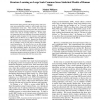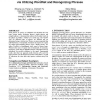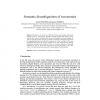250 search results - page 18 / 50 » Learning Probabilistic Models of Word Sense Disambiguation |
121
click to vote
AAAI
2008
15 years 2 months ago
2008
Research has shown promise in the design of large scale common sense probabilistic models to infer human state from environmental sensor data. These models have made use of mined ...
110
click to vote
SIGIR
2004
ACM
15 years 5 months ago
2004
ACM
Noun phrases in queries are identified and classified into four types: proper names, dictionary phrases, simple phrases and complex phrases. A document has a phrase if all content...
106
click to vote
CCIA
2007
Springer
15 years 6 months ago
2007
Springer
Polysemy is one of the most difficult problems when dealing with natural language resources. Consequently, automated ontology learning from textual sources (such as web resources) ...
NAACL
2003
15 years 1 months ago
2003
Homograph ambiguity is an original issue in Text-to-Speech (TTS). To disambiguate homograph, several efficient approaches have been proposed such as part-of-speech (POS) n-gram, B...
103
click to vote
LREC
2010
15 years 1 months ago
2010
Conventional methods for disambiguation problems have been using statistical methods with co-occurrence of words in their contexts. It seems that human-beings assign appropriate w...



